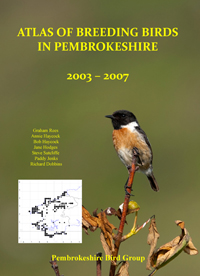For the last sixteen years I have holidayed in Pembrokeshire. The last ten years my parents have owned a static caravan in Saundersfoot which we used whenever possible. As a result, Pembrokeshire became my second "home" county. Over the years I have seen many good birds in Pembs and found a few rarities myself, so it was a big disappointment when we had to sell the caravan in December.
As a result, my father and I had to travel down to the caravan over the Chrimas break to clear it out. We travelled on the Friday morning (27th December) with the aim of returning home the following morning. By force of habit I packed my birding gear just in case we had time to spare. We cleared out the van quite quickly and I suggested we went out somewhere nearby; it was 1.30pm and so only a few hours of daylight remained. It was decided that we go to Lawrenny to view the estuary.
My previous visit to the site in September had produced 6 little egrets, so hopes were high. As we arrived, a big flock of birds took flight: a black and white swirling mass which turned out to be dunlins. This was far more than I had seen here in the past and as they settled down, I jumped out of the car and set up my scope. As I scanned the flock it was apparent that there were other waders mixed in. In all, over 1000 dunlins, 19 redshanks, 10 curlews, numerous oystercatchers, 11 grey plovers, 1 bar-tailed godwit and a fly-by peregrine. Quite a good half-hour's birding!
Apart from the waders, there were also a number of groups of wildfowl scattered around the estuary and so I began to identify the species. A surprise find was a pair of gadwalls in the creek about 50 yeards from the road. Newarby a couple of big groups of wigeons were feding on the shoreline and another small group on the mud bank, feeding on th exposed weed. I carefully viewed the two big groups on the shoreline for any other species but apart from a few teals nothing unusual stood out.
I see plenty of wildfowl on reservoirs back home, so the waders were of more interest, and as I shifted my attention a bird caught my eye. One of the wigeons feeding on the mud bank was looking straight at me and all that could be seen was the forehead blaze. However, on this bird it was creamy white colour unlike the yellow of Eurasian wigeon. Just as I started to suspect it could be the the American counterpart, the burd turned side on: a superb fully plumaged male American Wigeon.
I quickly pointed it out to my father but unfortunately there were no other birders to be seen. I have seen a number of American wigeons in the past and this was my second of the winter (the first being a long-staying bird on the Conwy estuary). However, this was the brightest individual that I have seen.
Very like Eurasian wigeon in build and character. Body pinkish brown with a paler greyish white head, peppered darker with an obvious dark metallic green band behind the eye. The classic identification feature is the white auxiliaries comparted to grey of Eurasion but there was no need to see this to confirm ID. With the sun behind us ites colours really showed up well. I watched it for about 10-15 minutes before we left and headed back to the caravan. Once back, I phoned Graham Rees and informed him and released the news on Birdline Wales.
The following morning we made a quick visit to Tenby before heading home. I wanted to look at "Birds of Pembrokeshire" to see the status of American Wigeon in Pembs. I found a copy in WH Smiths but could not find any reference to American Wigeon at all. Could it be a first for the County? Only now did I realise the significance of the bird and that most of the local birders were probably at the very moment frantically scanning the wigeon flock at Lawrenny in serch of the Yank.
Richard Stonier.
Footnote: Thanks to Richard's swift action, most local observers were able to enjoy seeing the striking, which stayed in situ into the New Year (eds)
Pembrokeshire Bird Report 1996
 Monday, January 30, 2017 at 10:59AM
Monday, January 30, 2017 at 10:59AM  Pembrokeshire Avifauna committee | Comments Off |
Pembrokeshire Avifauna committee | Comments Off |  vagrant in
vagrant in  American Wigeon
American Wigeon 

